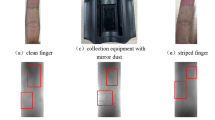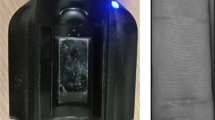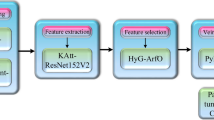Abstract
Based on the ever-growing emphasis on high security of biometrics recognition, finger vein recognition has captured more and more attention. However, due to the light scattering in human skin tissue during near-infrared light transmission imaging, the collected finger vein images are always degraded dramatically, which leads to the unreliability of vein features and the low accuracy of finger vein recognition. Although considerable traditional methods are dedicated to eliminating the effect of light scattering on imaging, the clearer images cannot be output end-to-end, the processes of restoring degraded finger vein images are laborious as well. Thereupon, with the aim at improving the visibility of finger vein features and generating clear finger vein images end-to-end, this effort represents a simple and effective method utilizing Convolutional Neural Network (CNN). First, in our previous work, the biological optical model used to settle the matter of skin scattering is modified to output restored finger vein images in an end-to-end manner. Second, a multi-scale CNN named E-Net is established to acquire credible estimation map of finger vein features, which is conducive to the acquisition of pleasurable restoration outcome. Finally, a scattering removal framework, addressed as Finger Vein Image Scattering Removal Network (FVSR-Net), is designed via integrating improved biological optical model with E-Net. Such a novel design facilitates the generation of clearer venous regions and increases computational efficiency and stability. Experiments accomplished on two finger vein datasets demonstrate the superiority of our proposed method in terms of visual quality and recognition performance.














Similar content being viewed by others
References
Cai B, Xu X, Jia K, Qing C, Tao D (2016) Dehazenet: an end-to-end system for single image haze removal. IEEE Trans Image Process 25(11):5187–5198
Chanukya PSVVN, Thivakaran TK (2020) Multimodal biometric cryptosystem for human authentication using fingerprint and ear. Multimed Tools Appl 79:659–673. https://doi.org/10.1007/s11042-019-08123-w
Fan DP, Cheng MM, Liu JJ, et al. (2018) Salient objects in clutter: bringing salient object detection to the foreground. In: proceedings of the European conference on computer vision (ECCV), pp 186-202
Fan DP, Zhang S, Wu YH, Liu Y, Cheng MM, Ren B, Rosin PL, Ji R (2019) Scoot: a perceptual metric for facial sketches. In: Proceedings of the IEEE International Conference on Computer Vision, pp 5612–5622
Fu B, Cui J, Xiong X (2010). A novel adaptive vein image contrast enhancement method based on fuzzy and Retinex theory. In: IEEE international conference on information and automation (ICIA). IEEE, pp 2447–2450
Golts A, Freedman D, Elad M (2019) Unsupervised single image dehazing using dark channel prior loss. IEEE Trans Image Process 29:2692–2701
Huang G, Liu Z, Van Der Maaten L, et al. (2017). Densely connected convolutional networks. In: Proceedings of the IEEE conference on computer vision and pattern recognition, pp 4700–4708
Kingma D, Ba J (2015) Adam: a method for stochastic optimization. 2015 international conference on learning representations (ICLR). arXiv:1412.6980
Lee E, Park K (2009) Restoration method of skin scattering blurred vein image for finger vein recognition. Electron Lett 45(21):1074–1076
Lee EC, Park KR (2011) Image restoration of skin scattering and optical blurring for finger vein recognition. Opt Lasers Eng 49:816–828
Li B, Peng X, Wang Z, Xu, J, Dan F (2017) AOD-net: all-in-one Dehazing network. In: Proceedings of IEEE International Conference on Computer Vision, Venice, pp 4780–4788
Liao X, Li K, Yin J (2017) Separable data hiding in encrypted image based on compressive sensing and discrete fourier transform. Multimed Tools Appl 76:20739–20753. https://doi.org/10.1007/s11042-016-3971-4
Liao X, Qin Z, Ding L (2017) Data embedding in digital images using critical functions. Image Commun 58:146–156. https://doi.org/10.1016/j.image.2017.07.006
Lu X, Wang W, Ma C, et al. (2019) See more, know more: unsupervised video object segmentation with co-attention siamese networks. In: Proceedings of the IEEE Conference on Computer Vision and Pattern Recognition, pp 3623–3632
Qin H, Chen Z, He X (2018) Finger-vein image quality evaluation based on the representation of grayscale and binary image. Multimed Tools Appl 77:2505–2527. https://doi.org/10.1007/s11042-016-4317-y
Ren W, Liu S, Zhang H, Pan J, Cao X, Yang MH (2016). Single image dehazing via multi-scale convolutional neural networks. In: Proceedings of European conference on computer vision, pp 154–169.
Ronneberger O, Fischer P, Brox T (2015). U-net: convolutional networks for biomedical image segmentation. In proceedings of international conference on medical image computing and computer-assisted intervention, pp 234-241
Shin KY, Park YH, Nguyen DT (2014) Finger-vein image enhancement using a fuzzy-based fusion method with gabor and retinex filtering. Sensors 14(2):3095–3129
Szegedy C, Liu W, Jia Y, et al. (2015). Going deeper with convolutions. In: Proceedings of the IEEE conference on computer vision and pattern recognition, pp 1–9
Tarel J. P, Hautiere N (2009). Fast visibility restoration from a single color or gray level image. In: Proceedings of 2009 IEEE 12th International Conference on Computer Vision, pp 2201–2208
Wang Z, Bovik AC, Sheikh HR et al (2014) Image quality assessment: from error visibility to structural similarity. IEEE Trans Image Process 13(4):600–612
Wang W, Shen J, Shao L (2018) Video salient object detection via fully convolutional networks. IEEE Trans Image Process 27(1):38–49
Wax AP, Backman V (2010). Biomedical applications of light scattering IV Biomedical applications of light scattering IV, 7573
Wen X, Zhao J, Liang X (2008) Image enhancement of finger-vein patterns based on wavelet denoising and histogram template equalization. Journal of Jilin University (Science Edition) 2:026
Yang J, Li X (2010). Efficient finger vein localization and recognition. In: Proceedings of international conference on pattern recognition, pp 1148–1151
Yang J, Shi Y (2012) Finger-vein ROI localization and vein ridge enhancement. Pattern Recogn. Lett. 33(12):1569–1579
Yang J, Shi Y (2014) Towards finger-vein image restoration and enhancement for finger-vein recognition. Inf Sci 1(268):33–52
Yang J, Wang J (2011). Finger-vein image restoration considering skin layer structure. In: proceedings of 2011 international conference on hand-based biometrics, pp 1-5
Yang J, Yan M. (2010). An improved method for finger-vein image enhancement. In: proceedings of the 10th IEEE international conference on signal processing (ICSP 2010), Beijing, pp 1706–1709
Yang J, Yang J (2009) Multi-channel gabor filter design for finger-vein image enhancement. In: Fifth international conference on image and graphics. IEEE, pp 87–91
Yang J, Yang J, Shi Y (2009). Combination of gabor wavelets and circular gabor filter for finger-vein extraction. In: proceedings of 5th international conference on intelligent computing, pp 346–354
Yang J, Zhang B, Shi Y (2012) Scattering removal for finger-vein image restoration. Sensors 12(3):3627–3640
Yin Y, Liu L, Sun X (2011). Sdumla-hmt: a multimodal biometric database. In: Biometric Recognition. Springer, pp 260–268
Zhang H, Li S, Shi Y, Yang J (2019) Graph fusion for finger multimodal biometrics. IEEE Access 7:28607–28615
Zhang J, Fan DP, Dai Y, et al. (2020) UC-net: uncertainty inspired rgb-d saliency detection via conditional variational autoencoders. In: Proceedings of the IEEE/CVF Conference on Computer Vision and Pattern Recognition, pp 8582–8591
Zhang J, Yu X, Li A, et al. (2020) Weakly-supervised salient object detection via scribble annotations. arXiv preprint arXiv:2003.07685
Zhao H, Gallo O, Frosio I, Kautz J (2017) Loss functions for image restoration with neural networks. IEEE Trans Comput Imaging 3:47–57
Zhao JX, Liu JJ, Fan DP, et al. (2019) EGNet: edge guidance network for salient object detection. In: Proceedings of the IEEE International Conference on Computer Vision, pp 8779–8788
Zhao JX, Cao Y, Fan DP, et al. (2019) Contrast prior and fluid pyramid integration for RGBD salient object detection. In: Proceedings of the IEEE Conference on Computer Vision and Pattern Recognition, pp 3927–3936
Author information
Authors and Affiliations
Corresponding authors
Ethics declarations
Conflict of interest
The authors declare that there is no conflict of interest regarding the publication of this paper.
Additional information
Publisher’s note
Springer Nature remains neutral with regard to jurisdictional claims in published maps and institutional affiliations.
Rights and permissions
About this article
Cite this article
Du, S., Yang, J., Zhang, H. et al. FVSR-Net: an end-to-end Finger Vein Image Scattering Removal Network. Multimed Tools Appl 80, 10705–10722 (2021). https://doi.org/10.1007/s11042-020-09270-1
Received:
Revised:
Accepted:
Published:
Issue Date:
DOI: https://doi.org/10.1007/s11042-020-09270-1




